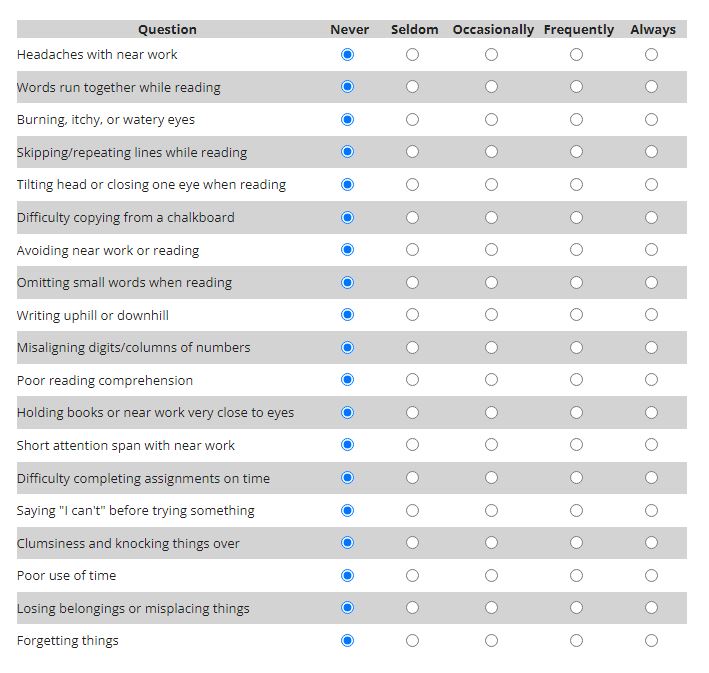Trusted educator, attorney, and retirement advisor
Learn more about Ms. Kotler by visiting
Endless Income
Ironically, it seems we should know if our own children are experiencing vision problems that interfere with their functioning. After all, who knows our children better than we do?
As it turns out, there can be visual system problems that we cannot see as outside observers. Perhaps we notice some eye-related complaints or symptoms but brush them off because we do not realize they are part of a larger, more serious problem.
Possibly, your child’s pediatrician or even his or her regular eye doctor have missed the symptoms as well. Why? They are not experts in the kinds of vision problems we are describing. Whether a child can see the letters on the Snellen eye chart from a certain distance, for example, or has glaucoma or some other eye health problem, is but one small part of how their eyes function together as a coordinated team.
Your child’s school may witness the symptoms of a vision problem, and may even misidentify it as something it is not (learning disability, dyslexia, dysgraphia, dyscalculia, ADD, ADHD, emotional disturbance, or even autism). This happens routinely because they simply are not the experts trained to properly identify the real root of the problem – the vision system.
For example, child who cannot sustain visual attention (fixate) on a teacher or on an assignment for a long period of time might be labelled as having attention deficit disorder, when, in reality, his visual system cannot maintain gaze because his eyes are not coordinating together properly. The brain fatigues from straining to integrate two different visual images constantly and must rest (look away). No ADD medicine can fix the true problem – the eyes.
Because only 2% of optometrists are board certified in developmental (also called, “behavioral”) optometry, most eye doctors do not have the training, expertise, time, and equipment necessary to do the kind of comprehensive evaluation your child might need. Even if you, as a loving and concerned parent, observe vision symptoms and take your child to the typical eye doctor, you might leave with a pair of glasses and not much more – which may or may not help improve your child’s vision system.
Our children may think the way they see the world is the way everyone else sees it also, since they have always experienced the world the same way. To them, how they take in information is “normal,” so-to-speak, because they have not lived any other way. Often, they suffer in silence without complaint. Other times they act out and get labelled as “bad.” Students become frustrated that they are forced to engage in tasks all day long they cannot physically do. Eventually, many of them give up. These are the ones who are truant or drop out of school. For these reasons, it is critical that you learn as much as possible, not only about symptoms to watch for, but also about possible treatment options and providers.
To start, it is extremely useful to know that the College of Vision Development has a screening tool on its website, called their “Quality of Life Survey.” The Survey looks like this:

To accurately complete the Survey, it would be best to work together with your child and his or her teachers. Some of these issues may be observable by you or the teachers, but some may not. For these answers, you can talk directly with your child if you don’t already know them.
This Survey used to be a checklist. If you checked “yes” to 3 or more of the symptoms, it was recommended to be seen by a board-certified developmental optometrist for a comprehensive evaluation. Today, this Survey has evolved into the interactive tool you see above. Therefore, the best thing to do is for you and your child’s teachers to complete the survey online, available at https://www.covd.org/page/QOLSurvey . Ask the teachers to do this separately for your child. The different results might be surprising.
You may even want to take the Survey for yourself, especially if you recall school as an unpleasant experience. Thanks to neuroplasticity of the brain, we’re never too old to improve our adult vision systems. Adults can benefit from vision system treatment, if necessary, although treatment usually proceeds more quickly for younger patients.
If your child is struggling in school, please complete this Survey as soon as possible. Once you do, click “Submit Survey” and the interactive website will give you the results, as well as recommendations for next steps.
Keep in mind that, in the event you do obtain a developmental optometry evaluation that yields vision problems, your child’s public school has a legal obligation to consider the results of that assessment. You can request in writing that the public school determine whether your child is eligible for special education and related services, as a student with a vision impairment.
In addition to specialized instruction, accommodations, technology, and modifications, your child might be entitled to related services such as vision therapy and occupational therapy, under the Individuals with Disabilities Education Act. For more information or assistance, you can reach me at mskotler1@gmail.com or (301) 401-1969.
If you would like to make an investment that lifts lives, brightens futures and strengthens the community, consider helping us. Please use the donate buttons below to select a secure method of online payment through PayPal, which allows donations by debit or credit card (PayPal keeps a two percent transaction fee for each donation).